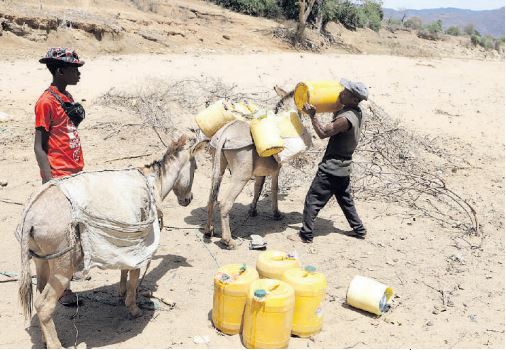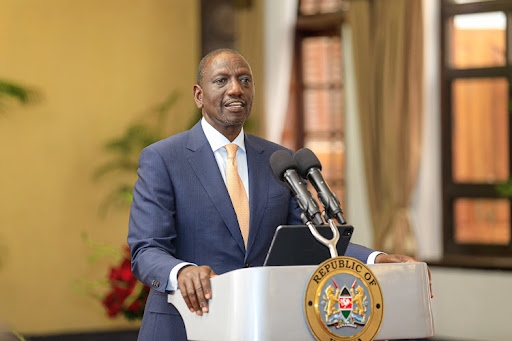 John Kamau draws water from a well in Voi River, Mwatate, Taita Taveta county on November 3, 2022 /FILE
John Kamau draws water from a well in Voi River, Mwatate, Taita Taveta county on November 3, 2022 /FILE
A news item about the Senate discussing a Bill about the Equalisation Fund (EF) prompted me to follow up.
Revenue raised nationally
Kenyan counties receive most of the money they need from the national government from “revenue raised nationally” (RRN), as the constitution puts it. Many of them could raise more money themselves than they do now (own source revenue), but that is not our issue today.
That national money gets to counties in different ways. The main one is the “equitable share”.
The total of this must not be less than 15 per cent of the RRN — not in the current year, but in the last year for which Parliament has approved the Auditor General’s annual audit report. The last year that audit report is 2020-21.
This money is not earmarked for particular purposes. For most counties, it is the main source of money for their general expenses. On average in 2023-24, 72 per cent of counties’ money came from the equitable share.
The second route is by grants — either conditional or unconditional. Conditional grants have particularly been given for health projects, but for several other purposes also, including the President’s Industrial Park scheme. Some unconditional grants have been given — for example from revenue raised from mining in a county.
Idea of Equalisation Fund
“Equality” is a word in the constitution’s Preamble, in Article 10 — a national value — is the subject of a whole Article in the Bill of Rights, and is a concept that permeates the whole document — reflected in words such as “inclusion”, and “minorities”.
The purpose of the Equalisation Fund is to make the country equal in terms of basic services, mentioning particularly water, roads, health facilities and electricity.
County roads, county health facilities, water services and electricity reticulation (networking) are all county, not national government responsibilities under Schedule Four of the constitution, and would surely be the “basic services” referred to in Article 204(2).
Incidentally, the EF is not unique to Kenya. It was to some extent inspired by arrangements in Switzerland and Canada.
A Swiss government publication says: “The 26 cantons and around 2,200 communes have extensive powers.
Fiscal equalisation is thus also important for the unity of the country. It is based on the principle of solidarity: the economically strong cantons and the confederation help out the economically weaker cantons.”
The Canadian Constitution says that “to ensure that provincial governments have sufficient revenues to provide reasonably comparable levels of public services at reasonably comparable levels of taxation.”
This money is not earmarked for specific purposes. The national government also does give some conditional grants to provinces.
An important thing to note is that in these countries there is no equivalent of the Kenyan general “equitable share.”
What is the process?
Article 204 introduces the idea of “marginalised areas”. The Commission on Revenue Allocation must give its advice and in fact, has produced two detailed policies on that issue.
The 14 counties as marginalised — mostly in the North, in the drier areas of the country, and at the Coast. The result was that the money in each of those counties was shared equally among constituencies, not focusing on the most marginalised within the county.
The second policy focuses on sublocations, rather than whole counties. CRA identified 1,424 areas as marginalised, using Kenya National Bureau of Statistics data. That recommendation goes to Parliament.
Article 204 says the national government either uses the money itself or gives conditional grants to the relevant counties.
The government chose a sort of hybrid approach. At the national level there is an Equalisation Fund Advisory Board; it seems that whenever something new is to be done, we set up some body — more posts, more patronage, more allowances.
The money does not go to the counties, but the way it is to be spent in a county involves the National Government Coordination System (the revived and renamed Provincial Administration), specifically the County Commissioner.
That officer heads a technical committee that includes the county executive member for finance, one county assembly member and two people connected to the CDF, as well as some people involved in implementing projects. (This is bad drafting — a county might have more than one constituency with marginalised areas.)
There is another committee at the subcounty level). Again, there is a CDF link — a complication since subcounties and constituencies are not always identical. And yet another — a Project Identification and Implementation Committee — at the ward level.
This carries out public participation and identifies specific projects.
The provision for specific allocation of the Equalisation Fund must go into an Act of Parliament — Article 204(3). This is the Bill the Senate has recently discussed. It allocates money to 34 counties, specifying which constituency/ies are to be beneficiaries.
Reflections and realities
The most brutal fact is that the whole system is barely functioning. Since it was set up, it ought to have received about Sh59.9 billion but has received only 13.4 billion.
Unlike in most government bodies, money unspent is carried forward to the next year. Each year the total that should be available increases because of the amount unpaid and the amount that ought to have been paid, but has not, increases.
Evidence before the Senate Committee considering the new Bill indicates that the annual Division of Revenue Bill allocates much less to the Equalisation Fund than it ought — about Sh6 billion. The CRA says it should be Sh8 billion.
The Council of Governors said the National Assembly has been cutting allocation to the Equalisation Fund through Supplementary Budgets and Appropriation Bills — quite unconstitutionally, as the EF amount is very specifically fixed.
I am wondering whether the whole idea was a mistake. Switzerland and Canada’s financial arrangements are very different from ours.
Already the division of the total equitable share between counties is to depend partly on issues such as poverty (Article 203). Should not extreme deprivation be part of this calculation?
The national government and MPs generally try to keep control of as much as they can, giving to counties reluctantly.
On the Equalisation Fund in 2023, MPs said things like, “There’s no way that the Equalisation Fund will be housed or domiciled within the counties.”
The NG-CDF — which is supposed to deal only with national responsibilities within constituencies — has muscled in on the Equalisation Fund, which deals mostly with county responsibilities. It has also been held unconstitutional by the courts, and will expire next year unless the Constitution is amended to retain it.
Counties ought already to have plans for the issues of basic services. Article 27 says the State (this includes counties within their responsibilities) must take measures to redress disadvantage because of past discrimination, which sometimes explains the lack of basic services in some parts of the country.
Water and health care are services that people have a constitutional right to (Article 43) — which turns a power of the counties to deal with these issues into a duty to do so, within their resources.
Simple good governance (another national value) should mean that counties exercise their powers to try to deal with precisely these sorts of problems. They should not think they can’t do anything unless they get something from the Equalisation Fund.
Not for the first time (look at bursaries), we have various agencies supposed to be doing the same thing — resulting in duplication of effort, and sometime double spending for the same beneficiaries.
True, we know counties don’t spend enough on development already. But is this a reason for taking the powers they ought to exercise away from them?
Or, since the Equalisation Fund constitutionally exists (until 2030 at least), perhaps it ought to be changed so that it involves conditional grants to counties to be spent — and accounted for — on the areas the CRA has identified as marginalised.

















